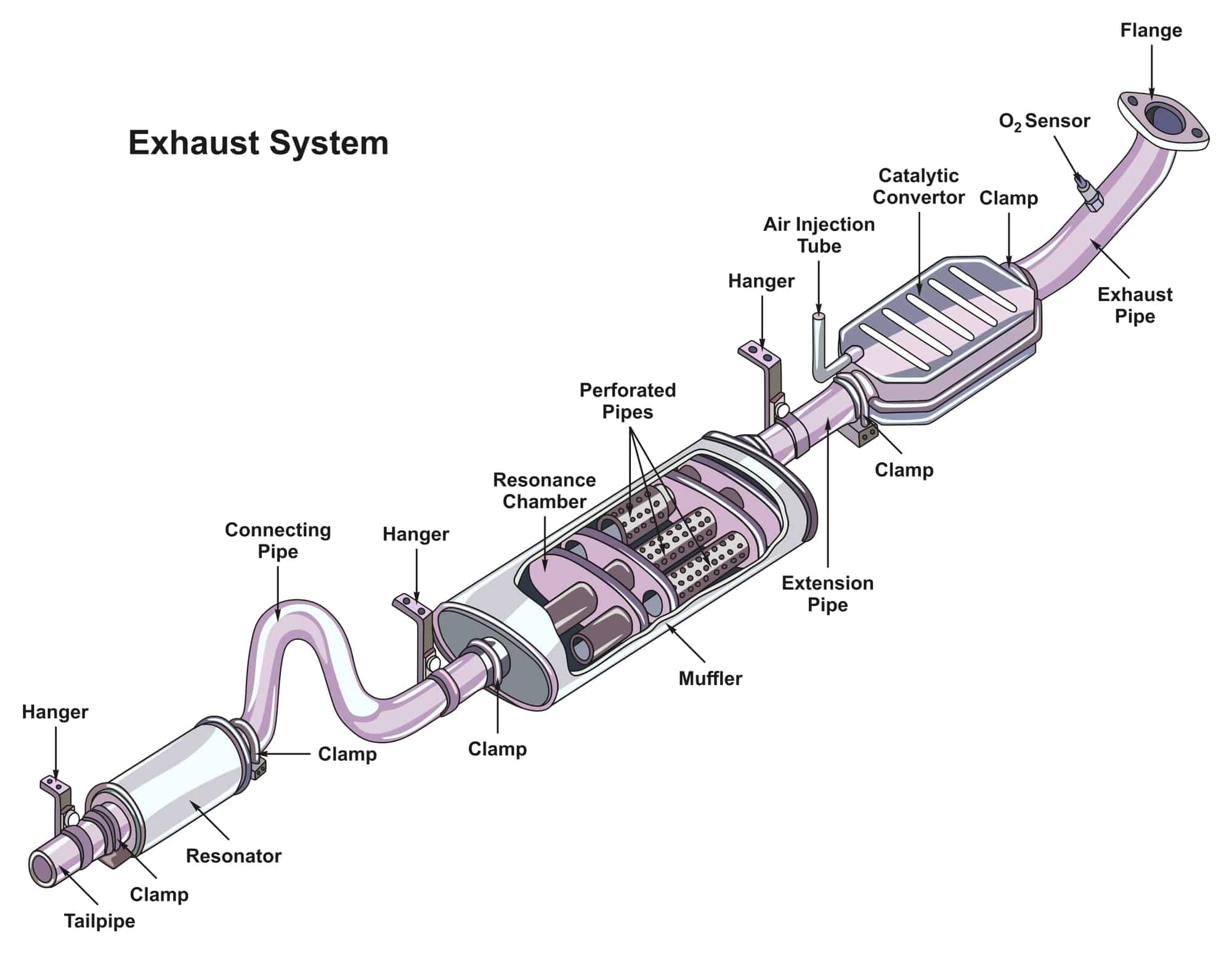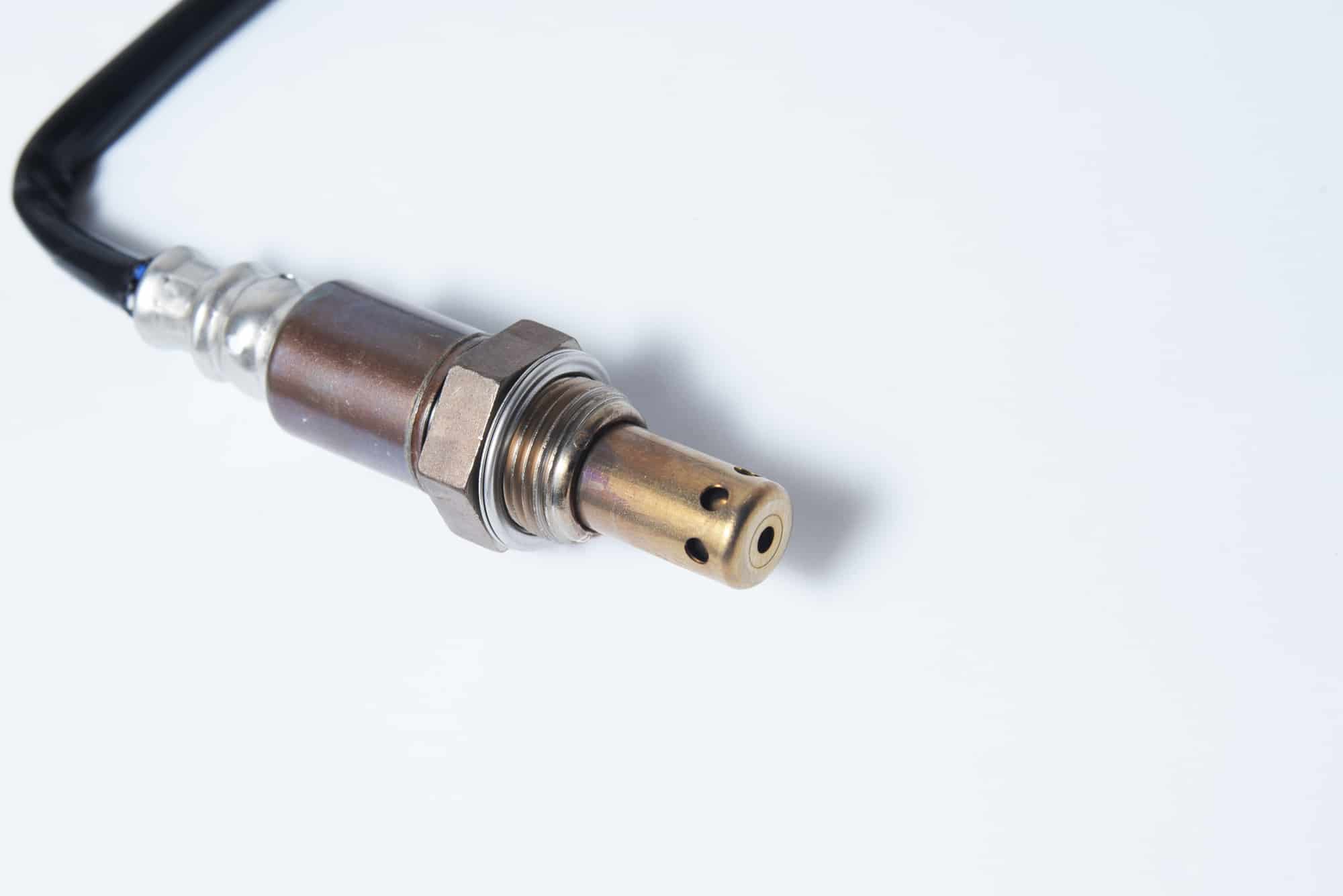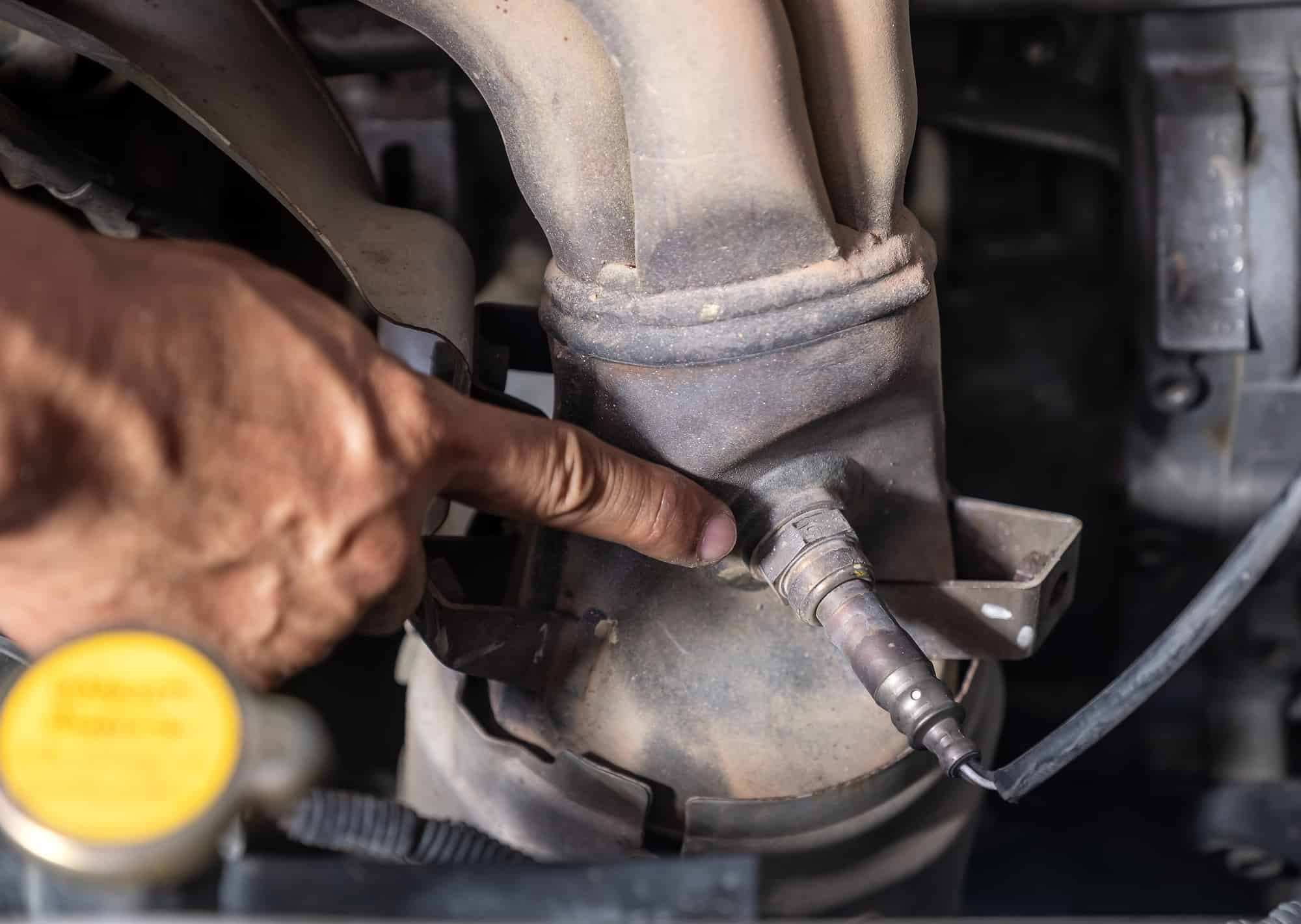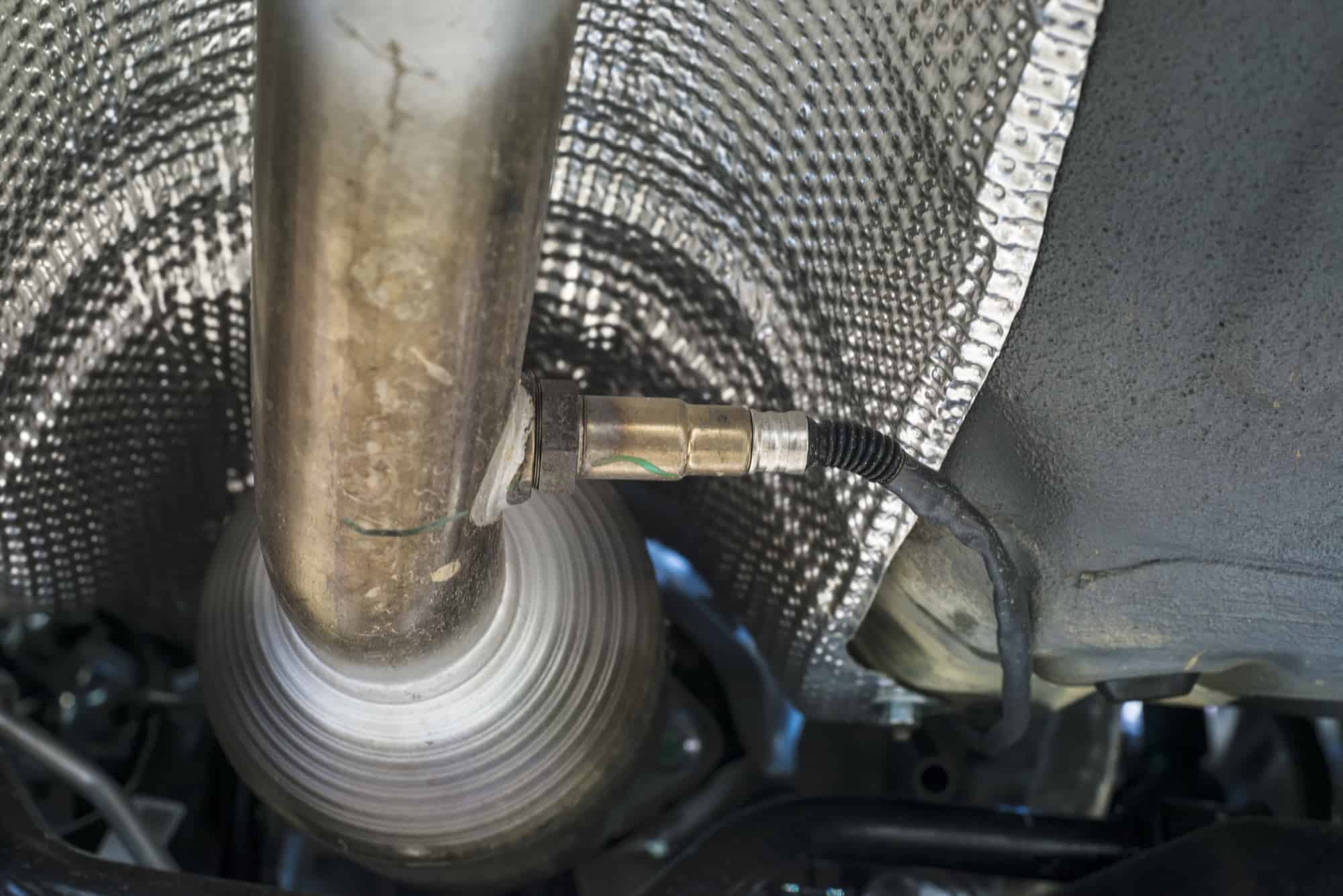Oxygen sensors are fitted to your car’s exhaust to monitor the combustion of fuel by keeping track of the amount of oxygen in the exhaust fumes. A bad oxygen sensor is going to affect how the engine operates as it will adversely affect the fuel to air mixture entering the engine. But how can you tell if one or more of the oxygen sensors has failed?
A bad oxygen sensor will usually trigger the check engine light, this is because the ECU will detect a problem with the data it is receiving from the failed oxygen sensor. This will usually be accompanied by symptoms such as poor fuel economy, a lack of engine power during acceleration, engine misfires, increased exhaust emissions, and a smell of fuel from the exhaust pipe.
If one or more of the oxygen sensors are faulty, then you are going to experience symptoms of an engine that is running too rich. Common engine error codes for faulty oxygen sensors include P0420 and P0140.
6 Common Symptoms Of A Bad Oxygen Sensor
The job of the oxygen sensors on your car is to monitor the gases coming out through the exhaust. This information is then used by the engine management module to adjust the air to fuel mixture to enhance the efficiency of the engine.
For an engine to run efficiently, the correct fuel to air ratio must be maintained under all driving conditions. By monitoring the amount of oxygen present in the exhaust gases, the engine management system can tweak the fuel mixture by altering the fuel delivery.
The oxygen sensors provide real-time analysis of the exhaust gases that can be used by the ECU. If an oxygen sensor is failing or is bad, then it won’t be able to provide an accurate reading of the oxygen levels in the exhaust system.
This will affect the performance of the engine and will often show up as tell-tale engine performance symptoms.
Symptom 1: Check Engine Light will come on
Because of the potential for engine misfires and even engine damage, you can expect the check engine light to flash or stay on after a few driving cycles with a damaged oxygen sensor.
Symptom 2: Poor fuel economy
Without proper information coming from the O2 sensor, the ECU won’t be able to accurately adjust fuel delivery, and a noticeable decrease in fuel economy can be evident.
Symptom 3: Rough Engine idle
Depending on the vehicle year and maker, the ECU may not be able to compensate for the failure of the oxygen sensor during idle. This might cause a rough idle or even an engine dying occasionally while idling. This is usually caused by the wrong amount of fuel entering each cylinder.
Symptom 4: Engine hesitation during acceleration
A bad oxygen sensor will make it hard for the ECU to adjust for the necessary amount of fuel during sudden acceleration. This can be because of the O2 sensor constantly running in “open loop mode” and not providing the ECU with accurate oxygen levels during acceleration. This can lead to a failure to accelerate when you push down on the gas pedal.
Symptom 5: Increased emissions
A faulty oxygen sensor will increase all emissions which could be a problem if you live in an area with smog checks or vehicle emissions testing.
Symptom 6: Gas smell from exhaust pipe
The failure to deliver the exact amount of fuel to the engine will cause a noticeable gas smell coming from your exhaust pipe.
How Does An Oxygen Sensor Work?
Depending on the year and maker of the vehicle you may find different types of oxygen sensors. From the old-style “classic” oxygen sensors to modern era ‘wideband’ AFR sensors. Most designs (old and new) are based on Zirconia sensors, where an electrochemical process is responsible for measuring the oxygen concentration.
Most similarities end there. Modern wideband oxygen sensors are capable of reporting the exact amount of oxygen content in the exhaust, not only if the mixture is rich or lean. The real-time feedback from the oxygen sensor gives the ECU the ability to adapt the fuel delivery quickly and efficiently under any driving condition.

Oxygen sensors also include a heater element. This helps the sensor core reach its operating temperature faster and hence start transmitting accurate information to the ECU as soon as possible. The heater circuit is controlled and constantly monitored by the ECU, that way it ensures everything is working as expected.
Oxygen sensors located before the catalytic converter are known as upstream sensors, while oxygen sensors located after the catalytic converter are called downstream sensors. Upstream sensors are usually more sophisticated because their role is to report to the ECU the oxygen concentration. Conversely, the downstream sensors main function is in helping the ECU to determine the catalytic condition.
Although all sensors are based on the same zirconia technology, but manufacturers implement the principles in different ways. That’s why it is highly advisable to find a reliable source of information regarding the specific wiring diagram for your vehicle before starting any diagnostic process.
How Long Do Oxygen Sensors Last?
Oxygen sensors are usually only replaced when they fail, or when engine performance deteriorates. They are not part of the regular service schedule, and most of the time they won’t need to be touched, especially on lower mileage vehicles.
Most oxygen sensors should last for at least 70,000 to 100,000 miles. Some enthusiasts believe that you should replace oxygen sensors at set mileage intervals, around every 50,000 miles. This can help to ensure that the engine always performs at its best and tihs can protect against misfires.
What Next – How Can You Tell Which Oxygen Sensor Is Bad?
For the purpose of this article, it’s assumed that you have a basic knowledge of safety precautions while working on your vehicle.
Depending on the type of oxygen sensor installed on your vehicle, you may need one or more of the following tools:
- OBD2 Code Reader
- Digital multimeter (DMM)
- Automotive diagnostic scanner with live data capabilities
A professional grade automotive scanner with live data graphing capabilities is not essential for testing the oxygen sensor but certainly would speed up the process no matter what type of sensor is installed.
Always refer to the appropriate OEM literature when possible. Original manufacturer diagnostic procedures should always have precedence over a generic workflow.

O2 Sensor when removed from the exhaust
1. Preliminary steps
Recommended tools: OBD2 Code Reader / automotive scan tool
> Data trouble codes: using an OBD2 code reader take note of any DTC present in the ECU memory. To do this you need to connect your code reader and turn the ignition key on (engine off), a state usually known as KOEO. Common engine error codes that may appear with a bad oxygen sensor include P0140, P0171 and P0174.
> Data trouble codes clear: now that you know what codes were stored into memory you need to clear them. This is usually done selecting “clear codes” in your tool.
> Driving cycle: disconnect your OBD2 code reader and start the engine, this state is commonly known as KOER (Key On Engine Running). If the Check Engine Light turns on then stop the engine and continue with the diagnostic. If the Check Engine Light remains off then drive the vehicle for 5 to 10 minutes. If the light remains off you may have an intermittent problem. If the light lit during your driving cycle then continue with the diagnostic process.
IMPORTANT: The following tests assume the O2 sensor harness is already unplugged, refer to “how to replace” section if you have any doubt.
2. Visual Inspection
Recommended tools: none
> Sensor wiring: perform a meticulous visual inspection of oxygen sensor wiring. Look for burnt, damaged, corroded or deteriorated wires. Pay special attention to possible shorts to ground or open circuits produced by a faulty insulation.
> Sensor harness connector: similar than before, perform an exhaustive visual inspection of oxygen sensor connector. Ensure the ignition key is switched off and unplug the oxygen sensor harness connector. Look for bent terminal pins, loosely connections, corrosion or any other possible indication of a bad connection.
Fix any wiring problem before continuing.
3. Electrical Tests
Recommended tools: digital multimeter (DMM)
> Supply voltage: as explained in this article, the oxygen sensor uses a heater element. The heater uses a 12V supply voltage to power itself. Without this power line, the oxygen sensor would not perform as intended.
Refer to the proper wiring diagram and identify the terminal corresponding to the +12V line. To measure the supply voltage, you will need to enter in KOEO mode (Key On Engine Off) and turn the digital multimeter dial to “voltage” test mode. Now place one multimeter probe in a known ground (battery negative is a good one) and the other probe tip in the terminal of the oxygen sensor wiring harness corresponding to the +12V supply. If the measured value is below 95% of the battery voltage then you will need to check the entire line from the oxygen sensor harness all the way to the ECU itself.
> Ground test: enter in KOEO mode (Key On Engine Off) turn the digital multimeter dial to “voltage” test mode and place one probe tip on the oxygen sensor harness terminal corresponding to the supply voltage and the other on the terminal that should be the ground. Ideally, the voltage would be the same value as the previous test, if the difference is greater than 10% then you will need to check electrical resistance and continuity of the ground line from the oxygen sensor harness all the way down to the ECU.
4. Scan Tool Tests
Recommended tools: automotive scan tool with live data capabilities.
Optional tools: a professional automotive diagnostic scanner with live data graphing ability.
> Upstream Oxygen Sensor live test: using an automotive diagnostic scanner you can perform upstream oxygen “live test”. First, enter in KOEO mode and lock the upstream oxygen sensor data on the display. Depending on your vehicle and scan tool maker you may have several items to check.
Focus on the oxygen voltage output. Once you are ready, start the engine to enter KOER mode. If your scan tool has a graphing ability turn it on. Graph engine RPM and oxygen output simultaneously. Accelerate the engine to 2000 RPM. You should see the voltage varying during acceleration and then stabilize. Decelerate to idle. You should see the opposite variation in the oxygen output.
Repeat the procedure several times. On “V-type” engines compare the results between banks. Some manufacturers include special tests for the oxygen sensors. Follow on-screen instructions to complete those tests. Please notice that oxygen sensor output is completely different between wideband models and narrowband models, refer to the appropriate OEM literature to determine their expected behavior.
> Downstream Oxygen Sensor live test: using an automotive diagnostic scanner you can perform downstream oxygen “live test”. First, enter in KOEO mode and lock the oxygen sensor data on the display. Depending on your vehicle and scan tool maker you may have several items to check.
Focus on the downstream oxygen voltage output. Once you are ready, start the engine to enter KOER mode. If your scan tool has a graphing ability turn it on. Graph engine RPM and oxygen output simultaneously. Accelerate the engine to 2000 RPM. You should see the voltage fairly stable.
Decelerate to idle. You should not see much variation in the oxygen output. Repeat the procedure several times. If the downstream output closely resembles the upstream oxygen sensor output then you may have a bad catalytic converter. Some manufacturers include special tests for the oxygen sensors. Follow on-screen instructions to complete those tests.
How Much does an O2 sensor cost?
A good quality oxygen sensor will normally cost between $50 and $100.
It shouldn’t take a mechanic any longer than a few hours to complete the job, so I’d expect to pay an extra $100 in labor costs, on top of the cost of the sensor.
Most cars have at least two oxygen sensors, and these are located on the exhaust system. They can be surprisingly difficult to replace because they can be difficult to access.
You will also need a special oxygen sensor tool to unscrew it from the exhaust. If you don’t have a dedicated workshop or vehicle ramp, then I’d recommend getting a mechanic to do the labor for you.
How To Replace A Bad Oxygen Sensor
The oxygen sensor is usually located near the catalytic converter inlet (upstream sensor) or close to the catalytic converter outlet (downstream sensor).

The Oxygen sensors are located near the catalytic converter
Recommended tools: OBD2 Code Reader, safety glasses, mechanics gloves, appropriate oxygen sensor wrench, proper illumination (LED flashlight),
- Preliminary steps: ensure the ignition switch is off and then disconnect the vehicle battery. Detaching the negative terminal is usually enough.
- Remove oxygen sensor connector: this step may be tricky in some models. Generally speaking, the connector has a plastic tab that you should push down while you pull out the harness. But in many cases, there is a small security clip (sometimes plastic, sometimes metallic) that must be removed first using an adequate screwdriver.
- Remove oxygen sensor: to remove the oxygen sensor you will need a special wrench, refer to your vehicle OEM information for details about the right size. This wrench is designed to ease your work not only with the sensor’s cable but for the challenge that represents loosening the sensor when it’s stuck.
- Install the new oxygen sensor: retire the old sensor and then install the new one. Double check that you’re using the adequate part number. Most sensors come with a special grease intended to be used on its threads. Don’t forget to use this compound, it will prevent the sensor from “soldering” to the exhaust pipe.
- Reconnect sensor and battery: once you are done, reconnect the sensor (don’t forget security clips) and then the battery terminal.
- Clear DTC memory: using the OBD2 code reader clear the ECU memory to prevent any false code been stored. You will need entering in KOEO mode for doing so.
- Perform driving cycle: once you are done, drive the vehicle for more than 10 minutes. Try to accelerate as you would normally do.
Related Questions – Signs Of A Bad Oxygen Sensor
1. Can a bad O2 sensor cause misfires?
Yes, as outlined above, a common sign of a bad or failing oxygen (o2) sensors is engine misfires. This is because the oxygen sensor feeds the oxygen concentration of the exhaust gases to the ECU and this is used to control the air to fuel ratio, the combustion process and the engine timing. A bad oxygen sensor will therefore cause a rough or irregular engine idle and engine misfires
2. Is it a bad oxygen sensor or catalytic Converter?
The symptoms of a bad oxygen sensor and a bad catalytic converter can be very similar, and sometimes it can be difficult to know which one has failed. To correctly diagnose the problem, each part will need to be inspected and any error codes retrieved from the ECU.
A properly functioning catalytic converter should have a higher inlet temperature than its outlet temperature when the engine is running at 2000 RPM. If the temperatures are closer in range, then this can point to a bad catalytic converter. You are also more likely to see the error code P0420.
It’s worth noting, that if the catalytic converter needs to be replaced then you should replace the oxygen sensors too.







I’ve been noticing my car struggling with acceleration and a slightly rougher idle than usual. After reading your explanation about oxygen sensors, I’m starting to suspect this might be the cause of my issues. How do I go about checking if the oxygen sensor is indeed the problem without having to visit a mechanic right away?
I’ve noticed my fuel economy has dropped recently and there’s a faint smell of gasoline from the exhaust. Could this be an indication of a failing oxygen sensor, or are there other issues I should consider first?